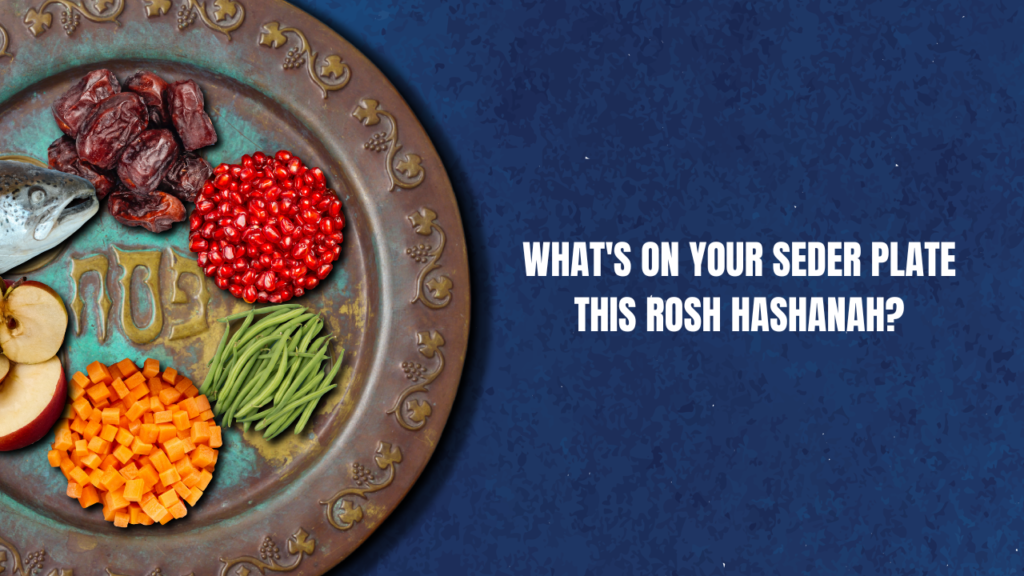Rosh Hashanah: What’s on your plate?

By Jamie Asaraf
Every year, the Jewish High Holidays come around, people attend services, families gather around, and still, no one knows how to set the dinner table when Rosh Hashana comes around. For many outside of the culture or religion, it also may seem like a silly dinner to have—who has small bite-size fruits and vegetables set for their guests to eat? It would never be filling enough.
But, the plate that sits on the table before the meal itself has a lot of significance for Jewish people, especially with the Jewish New Year, 5783, on the horizon. For those needing a refresher as to how to set their plates this year and for those wanting to understand the significance behind it all, here is your guide to the Rosh Hashana seder plate.
For context, the seder plate is a cultural tradition stemming from the Sephardic background which mainly includes Jews who were dispersed during the Spanish Inquisition to areas such as Africa and the Middle East. However, over the years, Jews of many different backgrounds have adopted this tradition in their own homes to add more meaning to their holiday.
Dates
The plate begins with a bite into a date and a blessing that this year will bring peace for us and the entire world. The symbolism of the dates plays on the Hebrew word for a date, Tamar, which is rooted in the word Tam. Tam means to end or to extinguish, so in this sense, we wish for the “end” of our enemies or those who seek the worst for us.
Pomegranates
It is believed that each pomegranate has 613 seeds in it, symbolizing the 613 Mitzvot (good deeds) that are written in the Torah. The number isn’t accurate, but feel free to count it yourself and see! Pomegranates tend to ripen in Israel during the high holiday season and have come to represent the idea of good deeds. So, when eating the seed this year, think about what good deeds you can do this year to make it a better year!
Rubia
Rubia isn’t a common word passed around day to day, but really it just means a bean or legume, so green string beans suffice for the table. Eating the Rubia represents a wish for prosperity and at the same time remembering those who are less fortunate so that we can give and share when we can.
Karti (Leeks or Scallions)
Karti plays off of the Aramaic word Yikartu meaning “will be cut off.” Similar to the dates, this is an ask that our enemies be cut off, but also a request to be surrounded by good friends and a good community.
Silka (Beets or Beetroot Leaves)
Eating the beets symbolizes a wish for freedom and growth in the coming year. Salka (Aramaic) resembles the Hebrew word Lehistalek meaning to retreat. So, we eat the beets while, again, asking that our enemies retreat and that we be free to follow our own paths.
Kara (Pumpkin or Gourd)
The Kara, meaning to tear or rend in Hebrew, often symbolizes our ask from G-d to tear up our bad deed from this past year and that our good merits be acknowledged and proclaimed. The Kara is also a reminder to count our blessings.
Gezer (Carrots)
When picking up the carrot, we keep in mind the Hebrew word for carrot which is Gezer. Gezer resembles the word Ligzor which means to cut. So, while eating the carrot, our wish is that G-d judges us with positive decrees and cut out our bad merits.
Head of a Fish
One of the most popular items on the seder plate is the head of a fish. Why the head you may ask, well, the head represents leadership. During Rosh Hashana, we wish to be at the head and not the tail in the coming year, we wish to be leaders and not stragglers. The word for head in Hebrew is actually Rosh. Hashanah means the year, so when you put them together, it translates to “Head of the [New]Year.”
Apples and Honey
Most famously known in the Rosh Hashanah tradition are the apples dipped in honey. Different customs have different ways of representing this on the plate. In Iraqi customs, it is traditional to eat a baked apple with sugar while in Ashkenazic customs, it is common for there to simply be sliced apples with honey. All of these variations represent a wish for a sweet year to come.



